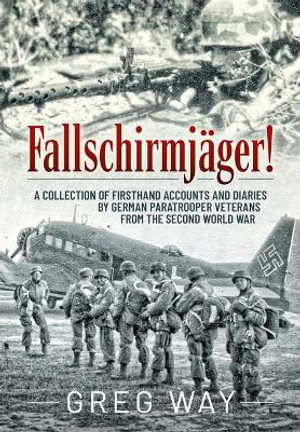
PublishedHelion & Company, October 2021 |
ISBN9781914059407 |
FormatSoftcover, 308 pages |
Dimensions24.5cm × 17cm |
Paratroopers or Fallschirmjager as they are known in German, were the elite parachute troops (Fallschirmtruppe) of the Luftwaffe during the Second World War. Although the Americans and Italians, and to a greater extent, the Russians had experimented with airborne troops, it was the Germans who pioneered vertical envelopment using parachute, glider-borne and air-landed troops to conduct successful airborne operations in the early stages of the war.
The man considered as the innovator and father of the German airborne forces was General Kurt Student and his vision would add a new dimension to warfare inspiring both the British and Americans to develop their own airborne forces. The newly raised Fallschirmjager formations took part in airborne and glider operations from April to May 1940 in Norway, Denmark, Belgium and Holland to attack and hold vital airfields, bridges and in one case an impregnable Belgian redoubt in support of ground operations in the west. On 20 May 1941, Fallschirmjager formations would take part in their largest airborne assault of the war, Operation Mercury, the airborne invasion of Crete. Due to the heavy losses incurred during this operation, Hitler vetoed any further large scale airborne operations. With the exception of several small scale parachute and glider missions, Fallschirmjager were mainly utilised as elite infantry for the remainder of the war fighting on all fronts and often used as a fire brigade to support conventional forces. AUTHOR: Gregory Way was born in southwest England in 1970. He joined the Royal Navy in 1988 and volunteered for the submarine service, completing his 22 years service in 2010. Having gained some experience in Naval maritime security and force protection he spent the next eight years working for a private maritime security company providing armed and unarmed protection for merchant ships in the worlds high risk areas. After 30 years in a maritime environment, Gregory decided upon a career change and in late 2018 started work with a global engineering company closer to home. With a lifelong interest in the Second World War, particularly the German military, he became interested in the Fallschirmtruppe during the 1990s and by chance in 1998 came into contact with several Fallschirmjager veterans. Having conducted further research, Gregory set up a website in 1999 detailing the exploits of this famous formation and in 2001 he decided to publish the first-hand accounts he had recieved over the years. The veterans were pleased that their stories could finally be told, in their own words. Gregory currently lives in Plymouth, England with his wife and two children. 256 b/w photographs and illustrations

